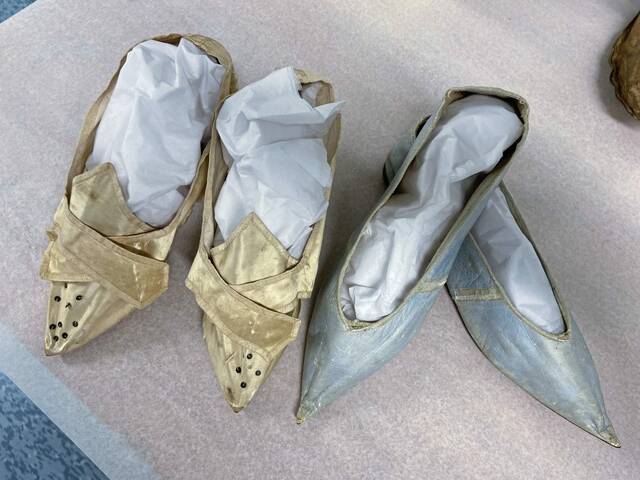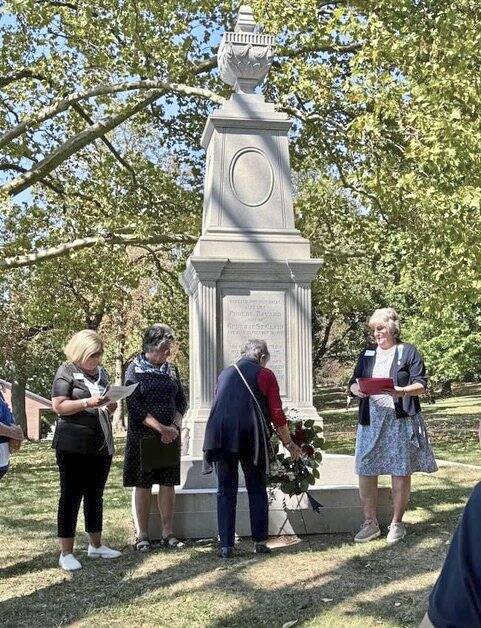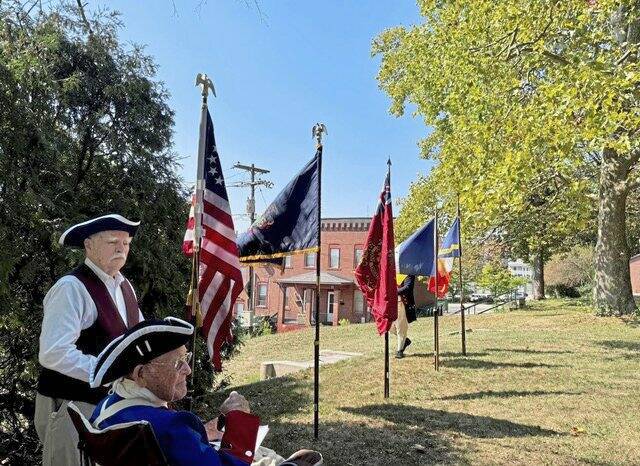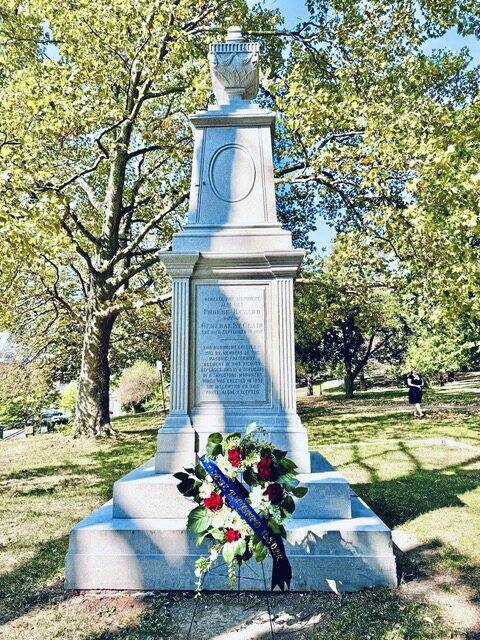Greensburg DAR chapter shines light on female patriot, rededicates St. Clair monument
Phoebe Bayard, described as an “American princess” in her youth, was born in 1743 in Boston to parents from two prominent and wealthy families.
When she died 75 years later, she was living in a log home on Westmoreland County’s Chestnut Ridge, after sacrificing her fortune and enduring long separations from her more well-known husband — Major Gen. Arthur St. Clair — in support of America’s birth and early development.
“Phoebe represented the sacrifices everyone was called to make for our freedom and fledgling country,” said Barbara Hurley, regent of the Greensburg chapter of the Daughters of the American Revolution, which chose to name itself after Bayard when it formed in 1896. “These sacrifices continued long after the war was won.”
Bayard brought an inheritance of 14,000 British pounds — about $3.5 million today — to her marriage to St. Clair. They were wed in 1760 in Boston, when she was not yet 17 and he, in his 20s, was a native of Scotland and a British lieutenant who served in the French and Indian War.
Bayard’s inheritance and additional wealth St. Clair accumulated eventually were lost to the couple. DAR officials note St. Clair tapped the family fortune to outfit soldiers he led in the Revolutionary War and to cover later expenses he incurred as Ohio-based governor of the Northwest Territory, but the funds never were reimbursed by the new United States government.
The Greensburg DAR chapter chose to shine a spotlight on the contributions of Bayard and St. Clair this year by having their graveside monument at Greensburg’s St. Clair Park professionally cleaned. Joined by three descendants of the couple and a General Arthur St. Clair Sons of the American Revolution color guard, local DAR members rededicated the monument on Sept. 14 — the anniversary of Bayard’s birth.
The Greensburg Masonic Fraternity erected the 18-foot monument in 1913, replacing an earlier marker.
After the cleaning, Hurley said, “We were amazed to find that under the gray-green accumulation of algae, dirt and pollution from old industrial Greensburg was a brilliant white granite monument just waiting to be found.”
The project is part of the DAR chapter’s participation in America250, a national campaign to recognize the country reaching a milestone of two and a half centuries in 2026.
In addition to Bayard, Hurley said, “The DAR is looking to find more female patriots, as women were obscured in history. There is information there. It is just more difficult to find.”
Clues in correspondence
Bayard’s support of her husband on the home front while raising a growing family and missing loved ones in Massachusetts is revealed, in part, through his correspondence.
St. Clair was assigned to oversee forts that had been established along Pennsylvania’s Forbes Road — including Fort Bedford, where the family initially settled.
St. Clair wrote in 1766 that his new role had “an air of some importance which prevents my Wife from reflecting so much upon the misfortune that has happened her….”
Three years later, he wrote that he had “left Mrs. St. Clair & the children well about ten days ago, but she is extremely impatient to hear from her Friends in Boston, particularly Her Father & Mother, whom she begins to think have entirely forgot Her.”
When St. Clair moved his family to the village developing near Fort Ligonier, he found success in farming and operating a grist mill. But, in December 1775, when he accepted the rank of colonel in the Pennsylvania militia, he relocated the family to current-day Pottstown, about 40 miles from Philadelphia.
There, his wife remained separated from him for the better part of seven years as he led Revolutionary troops, advancing to the rank of major general.
“The stress of the war, another move, and separation from Arthur probably started Phoebe’s decline into chronic depression,” according to a presentation about Bayard by Joan Drexler, registrar of the Greensburg DAR chapter. “Her oldest, Daniel, not 16 yet, also going to fight was not helpful to Phoebe’s emotional state.”
“Today we would realize Phoebe’s malaise may have stemmed from any number of physical conditions,” Hurley added. “The medical community in the 18th century just didn’t have the knowledge or treatment that we have today.”
‘Sacrificed all she had’
Phoebe Bayard had seven children, one of whom suffered an early death.
Hurley noted Phoebe was separated again from members of her immediate family when her husband left in 1788 to begin a 14-year term as governor of the Northwest Territory, accompanied by three of their children.
When the couple were reunited and returned to Ligonier, they lost their holdings — including their “Hermitage” home near Ligonier — to creditors and spent the rest of their days in the log house on the ridge, where they operated a roadhouse.
St. Clair died on Aug. 31, 1818, after being injured in a wagon accident on the ridge road down to Youngstown. His wife died 18 days later.
Visitors to the reconstructed Fort Ligonier can gain an idea of how the St. Clairs lived when their fortunes were at their peak. The parlor of the Hermitage has been restored and is part of the fort’s museum. Though not on public display, the museum also has a collection of period apparel associated with Phoebe that were donated by St. Clair descendants: two gowns, two beaded purses, two pairs of shoes and a silk shawl.
In 1935, the DAR dedicated a bronze plaque to the St. Clairs, placed on a stone near where their final log house stood. It honors “the beautiful, cultured and wealthy woman, who sacrificed all she had for the liberty of the American colonies” and “her soldier husband Maj. Gen. Arthur St. Clair, who was one of Washington’s faithful friends and trusted officers.”
Jeff Himler is a TribLive reporter covering Greater Latrobe, Ligonier Valley, Mt. Pleasant Area and Derry Area school districts and their communities. He also reports on transportation issues. A journalist for more than three decades, he enjoys delving into local history. He can be reached at jhimler@triblive.com.
Remove the ads from your TribLIVE reading experience but still support the journalists who create the content with TribLIVE Ad-Free.






